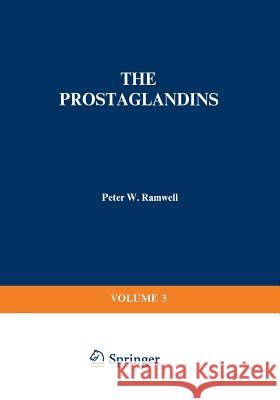The Prostaglandins: Volume 3 » książka



The Prostaglandins: Volume 3
ISBN-13: 9781461580577 / Angielski / Miękka / 2012 / 360 str.
The Prostaglandins: Volume 3
ISBN-13: 9781461580577 / Angielski / Miękka / 2012 / 360 str.
(netto: 192,11 VAT: 5%)
Najniższa cena z 30 dni: 192,74
ok. 22 dni roboczych
Dostawa w 2026 r.
Darmowa dostawa!
1 Gas Chromatography-Mass Spectrometry of Prostaglandins.- I. Introduction.- A. Identification of Prostaglandin Synthetase Dependent Substances.- B. Metabolites of Prostaglandins.- C. Quantification.- II. Mass Spectrometry Systems for Prostaglandin Analysis.- A. Magnetic Focusing Instruments.- B. Quadrupole Instruments.- C. Choice of Internal Standard and Derivative.- III. Methods of Extraction and Chromatography.- A. Extraction of PGs, Their Circulating Metabolites, and Thromboxane B2 from Blood Plasma.- B. Extraction of Prostaglandins from Urine.- C. Methods of Chromatography of Prostaglandins and Prostaglandin Metabolites.- IV. Biological Applications.- A. Circulating Prostaglandins.- B. Urinary Prostaglandins.- C. Prostaglandins and Renin.- D. Assessment of Prostaglandin Synthesis.- V. References.- Note Added in Proof.- 2 Prostaglandin Biosynthesis and Metabolism as Measured by Radioimmunoassay.- I. Introduction.- II. Serological Specificities of the Prostaglandin Immune Systems.- A. Prostaglandin Synthetase.- B. Prostaglandin E 9-Ketoreductase.- C. 15-Hydroxyprostaglandin Dehydrogenase.- D. Prostaglandin ?13-Reductase.- E. PGE Dehydrase and PGA and PGC Isomerases.- III. Prostaglandin Synthetase.- A. Cofactor Requirements.- B. Activation and Inhibition of Microsomal Prostaglandin Biosynthesis by Cytoplasmic Fractions.- C. Solubilization and Resolution of a Prostaglandin Synthetase System.- D. The pH Optima of Prostaglandin Synthetase Systems.- E. Inhibition of Prostaglandin Synthetase from Different Tissues of the Same Species by Nonsteroidal Anti-inflammatory Drugs.- IV. Prostaglandin E 9-Ketoreductases.- A. Cofactor Requirements and Tissue Distribution of PGE 9-Ketoreductase.- B. Purification and Properties.- V. 15-Hydroxyprostaglandin Dehydrogenases.- A. Detection and Tissue Distribution of NAD+-Dependent and NADP+™Dependent 15-Hydroxyprostaglandin Dehydrogenases.- B. Purification and Properties of the NAD+- and NADP+- Dependent Dehydrogenases.- VI. Prostaglandin ?13-Reductase.- VII. PGE Dehydrase, PGA Isomerase, and PGC Isomerase.- VIII. Regulation of PGE and PGF Levels.- IX. References.- Note Added in Proof.- 3 The Endocrine System: Interaction of Prostaglandins with Adenylyl Cyclase-Cyclic AMP Systems.- I. Introduction.- II. Thyroid.- III. Pituitary.- A. Introduction.- B. LH/FSH.- C. ACTH.- D. Prolactin.- E. Growth Hormone.- F. Thyroid Stimulating Hormone.- G. Summary.- IV. Pancreas.- V. Adrenal.- VI. Ovaries.- A. Effects of Cyclic AMP and Prostaglandins on Steroidogenesis.- B. Effects of Prostaglandins on Adenylyl Cyclase.- C. Additivity of LH and Prostaglandins on Adenylyl Cyclase.- D. Effects of Inhibitors of Prostaglandin Synthesis on LH Action.- E. Adenylyl Cyclase in Follicles from Immature and Adult Rats.- F. Adenylyl Cyclase, Prostaglandin Synthesis, and Steroidogenesis in Preovulatory Follicles.- VII. References.- 4 Induction of Labor with Prostaglandins.- I. Historical Background.- II. Induction of Labor with Intravenous Prostaglandins.- III. Other Routes of Administration.- IV. Conclusions.- V. References.- 5 Cardiovascular Responses to the Prostaglandin Precursors.- I. Introduction.- II. Blood Pressure.- A. Arachidonic Acid.- B. Dihomo-y-linolenic Acid.- C. 5, 8, 11, 14, 17-Eicosapentaenoic Acid.- D. PG Endoperoxides.- III. Cardiac Effects.- IV. Renal Circulation.- V. Pulmonary Circulation.- VI. Other Regional Circulations.- VII. Platelets 141 VIII Summary.- IX. References.- 6 Role of Prostaglandins in Fever and Temperature Regulation.- I. Introduction.- A. Temperature Regulation B. Fever 148.- II. Role of PGs in Fever.- III. PG Synthesis in Brain during Fever.- A. Appearance of PGs in Cerebrospinal Fluid.- B. Presence of PGs in the AH/POA.- C. Source of PGs.- IV. Difficulties with the PG Hypothesis.- A. Lesions of the AH/POA and Fever.- B. Lack of “Prostaglandin Fever” in Lambs.- C. PG Antagonists.- D. Action of PGs on Single Hypothalamic Neurons.- V. PGs in Normal Temperature Regulation.- A. Antipyretics and Normal Temperature Regulation.- B. PG Efflux in Afebrile Animals.- VI. Summary of the Existing Evidence.- VII. Addendum.- VIII. References.- 7 Prostaglandins and the Lung.- I. Introduction.- II. Prostaglandin Content and Synthesis in the Lung.- A. Content.- B. Synthesis.- III. Catabolism and Uptake of Prostaglandins in the Lung.- A. Catabolic Enzymes.- B. Uptake and Inactivation.- IV. Release of Prostaglandins from the Lung.- A. Mechanical and Chemical Stimuli.- B. Antigen-Antibody Reaction and Other Physiological and Pathological Stimuli.- C. Inhibition of Prostaglandin Release.- D. Possible Role of Prostaglandins in Bronchial Asthma and Other Lung Diseases.- V. Bronchopulmonary Effects of Prostaglandins.- A. F Prostaglandins.- B. E Prostaglandins.- C. A and B Prostaglandins.- D. Endoperoxide Intermediates and Metabolites.- E. Interaction of Prostaglandins and Indomethacin and Their Relation to the Tone of Airways.- F. Effects of Prostaglandins on Pulmonary Circulation 205 VI. Interaction of Prostaglandins with Cyclic Nucleotides in the Lung.- VII. Summary and Conclusions.- VIII. References.- Note Added in Proof.- 8 Prostaglandins and the Digestive System.- I. Introduction.- II. Salivary Glands.- III. Esophagus.- IV. Stomach.- A. Motility.- B. Gastric Secretion.- C. Ulcer Formation.- D. Mechanism of the Antisecretory Action.- E. Physiopathological Role of Prostaglandins 246 V. Intestine.- A. Intestinal Secretion and Absorption.- B. Enteropooling Assay.- C. Diarrhea.- VI. Bile and Pancreatic Secretion.- A. Bile Secretion.- B. Pancreatic Secretion.- VII. Cytoprotection by Prostaglandins.- A. Intestine.- B. Stomach and Duodenum.- C. Mechanism of Cytoprotection.- VIII. References.- 9 Prostaglandins and Renal Function, or “A Trip down the Rabbit Hole”.- I. Introduction.- II. Prostaglandin Synthesis and Metabolism.- A. Renal Prostaglandin Synthesis.- B. Prostaglandin Inactivation.- III. Role of Prostaglandins in the Control of Renal Blood Flow.- A. Studies within the “Autoregulatory” Range.- B. Relationship to Renal Ischemia.- C. Relationship to Renal Hyperemia.- D. Interdependence of Prostaglandins and Renal Vasoactive Phenomena.- IV. Role of Prostaglandins in Salt and Water Homeostasis.- A. Prostaglandins Are Natriuretic.- B. Prostaglandins Are Antinatriuretic.- C. Prostaglandin-Induced Alterations in Water Homeostasis.- V. Conclusion.- VI. References.- Note Added in Proof.- 10 Prostaglandins and Cancer.- I. Introduction.- II. Prostaglandin Synthesis by Tumors and Its Effects on Tumor Cell Replication.- A. In Vitro Studies.- B. In Vivo Studies.- III. Prostaglandins, Bone Resorption, and Hypercalcemia.- A. The Bone Resorptive Effect of Prostaglandins.- B. PGE as the Mediator of Hypercalcemia in Vivo.- IV. Conclusions.- V. References.
1997-2025 DolnySlask.com Agencja Internetowa
KrainaKsiazek.PL - Księgarnia Internetowa









